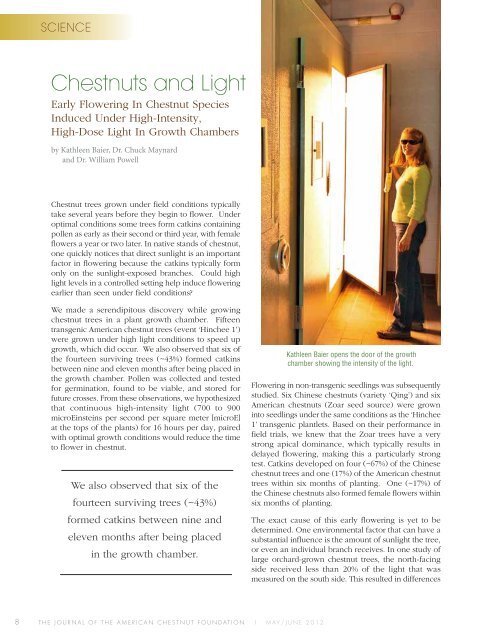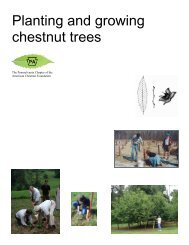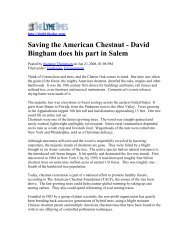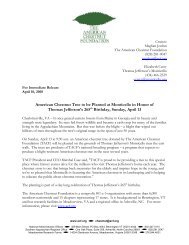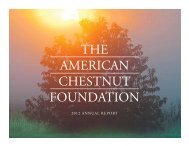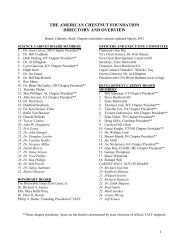mAY/June 2012 - The American Chestnut Foundation
mAY/June 2012 - The American Chestnut Foundation
mAY/June 2012 - The American Chestnut Foundation
You also want an ePaper? Increase the reach of your titles
YUMPU automatically turns print PDFs into web optimized ePapers that Google loves.
SCIENCE<br />
<strong>Chestnut</strong>s and Light<br />
Early Flowering In <strong>Chestnut</strong> Species<br />
Induced Under High-Intensity,<br />
High-Dose Light In Growth Chambers<br />
by Kathleen Baier, Dr. Chuck Maynard<br />
and Dr. William Powell<br />
<strong>Chestnut</strong> trees grown under field conditions typically<br />
take several years before they begin to flower. Under<br />
optimal conditions some trees form catkins containing<br />
pollen as early as their second or third year, with female<br />
flowers a year or two later. In native stands of chestnut,<br />
one quickly notices that direct sunlight is an important<br />
factor in flowering because the catkins typically form<br />
only on the sunlight-exposed branches. Could high<br />
light levels in a controlled setting help induce flowering<br />
earlier than seen under field conditions<br />
We made a serendipitous discovery while growing<br />
chestnut trees in a plant growth chamber. Fifteen<br />
transgenic <strong>American</strong> chestnut trees (event ‘Hinchee 1’)<br />
were grown under high light conditions to speed up<br />
growth, which did occur. We also observed that six of<br />
the fourteen surviving trees (~43%) formed catkins<br />
between nine and eleven months after being placed in<br />
the growth chamber. Pollen was collected and tested<br />
for germination, found to be viable, and stored for<br />
future crosses. From these observations, we hypothesized<br />
that continuous high-intensity light (700 to 900<br />
microEinsteins per second per square meter [microE]<br />
at the tops of the plants) for 16 hours per day, paired<br />
with optimal growth conditions would reduce the time<br />
to flower in chestnut.<br />
We also observed that six of the<br />
fourteen surviving trees (~43%)<br />
formed catkins between nine and<br />
eleven months after being placed<br />
in the growth chamber.<br />
Kathleen Baier opens the door of the growth<br />
chamber showing the intensity of the light.<br />
Flowering in non-transgenic seedlings was subsequently<br />
studied. Six Chinese chestnuts (variety ‘Qing’) and six<br />
<strong>American</strong> chestnuts (Zoar seed source) were grown<br />
into seedlings under the same conditions as the ‘Hinchee<br />
1’ transgenic plantlets. Based on their performance in<br />
field trials, we knew that the Zoar trees have a very<br />
strong apical dominance, which typically results in<br />
delayed flowering, making this a particularly strong<br />
test. Catkins developed on four (~67%) of the Chinese<br />
chestnut trees and one (17%) of the <strong>American</strong> chestnut<br />
trees within six months of planting. One (~17%) of<br />
the Chinese chestnuts also formed female flowers within<br />
six months of planting.<br />
<strong>The</strong> exact cause of this early flowering is yet to be<br />
determined. One environmental factor that can have a<br />
substantial influence is the amount of sunlight the tree,<br />
or even an individual branch receives. In one study of<br />
large orchard-grown chestnut trees, the north-facing<br />
side received less than 20% of the light that was<br />
measured on the south side. This resulted in differences<br />
8 <strong>The</strong> Journal Of <strong>The</strong> <strong>American</strong> <strong>Chestnut</strong> <strong>Foundation</strong> | MAY/JUNE <strong>2012</strong>


